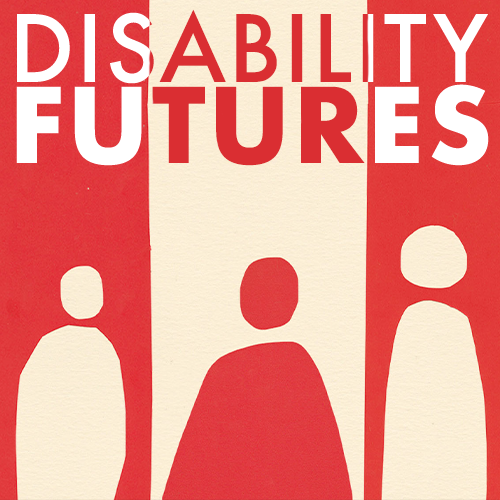

Read the next installment: “Choreographing the Physicality of My Bodies”
Read the previous installment: “The Power of Finding a Disabled Community Online”

I remember Mr. Wollny quite vividly–he was one of the first disabled people that I met. It was the first day of elementary school, a hot August morning in northern Germany, 1981. Mr. Wollny was the school’s director, and I was scared of this uncanny old man; I remember staring at his arm stump peeking out of his short-sleeved shirt. Just like the other kids were staring at me: too small for a six-year-old, with legs too fragile to stand on or even walk, I was carried in my mother’s arms.
Before entering elementary school, the term “disability” had no relevance to me. I had no idea what that disability thing had to do with me. All I knew was that I had brittle bones and that I couldn’t walk. I didn’t even have a wheelchair until I was ten. Until then, I used a tricycle and a stroller, crawled around the house, or was carried by my parents and siblings. It took several doctors’ notes, psychological exams, and intelligence tests to prove that I was worthy enough to be educated alongside “healthy” kids.
I don’t think that Mr. Wollny’s disability had anything to do with letting me into this mainstream school. I’ve always assumed that he was wounded in the Second World War, as a lot of older men back then were, though I never knew for certain. I don’t know if he even thought of himself as disabled. The fact that the school let me in had everything to do with my mother’s persistence on inclusion–even though that word was unheard of in 1981.
Until well into the 1990s, special schools were mandatory for disabled children in Germany. Had I attended one of them, I would have been picked up by a bus at 6 a.m. and driven to a school about 30 kilometers (nearly 20 miles) from my home, and would not have returned until 4 p.m. Like the majority of disabled people in Germany, I probably would never have completed my Abitur, Germany’s qualification requirement to go to university. I most likely would not have been able to write this essay. My mother knew about my prospective life, and, having heard about other successful attempts at “integration,” as it was called at the time, she was fierce enough to fight school authorities and get me into that mainstream neighborhood school–an “exception to the rule.”
In Germany today, parents can theoretically choose which school to send their kids to. In reality, German schools are still allowed to reject children with disabilities when they think that they can’t make suitable accommodations. Compared to the 1980s, many more disabled children now go through the mainstream school system, but these loopholes remain. It’s been 10 years since Germany signed the United Nations Convention on the Rights of Persons with Disabilities (CRPD), but inclusion remains a hot topic in German media and society today–and in few other areas does it cause so much controversy as in the school system.

The result of a decade of school inclusion looks pretty poor: 4.3 percent of German children are educated in special schools today, a slight improvement compared to the rate of 4.9 percent in 2009. But compared to rates in other rich countries, this is still a very high percentage. In places like the U.K., the U.S., Italy, and the Scandinavian countries, teaching children with and without disabilities in the same schools has been common for decades.
In some regions of Germany, the exclusion rate is rising. In mainstream schools, teachers and parents worry that disabled students will impede the class’s performance. Government-prescribed inclusion fails to provide funding for additional instructors, assistance, or disability access in schools, leaving teachers overwhelmed as they try to cater to the variety of needs in their classrooms. Media commentators claim that inclusion promotes an unnecessary “leveling down,” and view special schools as “safe havens” for vulnerable children who are better off learning “among their own kind.” But poor conditions in these special schools–including extremely low standards of education–are only highlighted by inclusion activists and former students.
The narrative of sheltering disabled people in separate, “special” places is even more widespread when it comes to employment. Over 300,000 disabled people in Germany work in what are known as “sheltered workshops.” These facilities function as a continuation of special schools, especially for people with cognitive and mental disabilities; almost all alumni of such schools end up in sheltered workshops, and less than 1 percent of workers at these facilities progress to a job in the regular job market.
The average income for these workers is 150 euros per month, subsidized by welfare benefits. They are not allowed to go on strike or form unions. They don’t count as regular employees but as “rehabilitants”–what they do doesn’t count as work but as “therapy.” Larger companies in Germany are obliged to pay a fine if they fail to hire a mandated number of disabled people, so they often contract sheltered workshops for their production. These shops offer a low-cost job market–and their directors and the country’s politicians claim them to be part of an “inclusive” society.
Germany’s relationship to disability has long been problematic. During the World War II, the Nazis murdered as many as 300,000 disabled people during the Aktion T4 involuntary euthanasia program. Approximately 350,000 others underwent forced sterilization. But after 1945, Germany failed to reconsider its disability politics. The eugenic idea that disabled people should either be useful to the community or dead remained popular around the world–and especially in Germany.
After the war, German authorities focused on turning the disabled into a productive labor force. In West Germany, this meant handing over responsibility to charitable organizations rather than the state. Some Scandinavian countries began to adopt ideas of normalization and community integration as early as the 1950s; Germany, by contrast, continued involuntarily institutionalizing disabled people–as it had done before the Nazis–until well into the 1980s, but in West Germany, they put a benevolent face on the practice. We are still dealing with the effects of these policies today, especially since not all charity organizations meet the CRPD’s definition of inclusion.

When I entered elementary school, I was the first student in that school with a disability. I was their test case for inclusion–still called “integration”–and I dared not mess up the experiment. I performed well enough to get my Abitur, made a lot of nondisabled friends, and joined the school’s theater group. I was bullied in fifth and sixth grades, then again in ninth and tenth. I had a lot of things to grapple with: the teachers wanted my mother to accompany me on school trips even when I was 18; my body looked painfully different from the bodies of other adolescents; I never had a boyfriend like the “normal” girls did.
I longed for a community where I wasn’t “the first one” or “the only one.” The peers that I would have needed were largely absent in my mainstreamed childhood and teens–and for a long time, I didn’t have a clue that being disabled meant more than living under a constant threat of being expelled.
The experience did, however, give me a valuable perspective on making meaningful contributions to the world, although I didn’t find a home in the disability rights movement until much later. I was proud to be mainstreamed: it led me down a path that people could praise as “inclusive” and “normal.” In that version of inclusion, in order to be accepted you have to perform well, adapt to normative standards, and renounce your difference. Even today, regardless of whether you’re disabled or not, many societies privilege an idea of “independence”: not being “a burden” but living a self-sufficient, autonomous life. Ironically, the pressure of “compulsory able-bodiedness,” as critical disability studies theorist Robert McRuer calls it, is something that no one can really live up to.
By no means do I suggest that we should dump inclusion and go back to segregated times. To the contrary, my utopia of an inclusive world would be a society in which individual contributions count, no matter what they look like, rather than just individual performance or productivity. Imagine a society that doesn’t need a fixed construction of “who is disabled” and “who is able,” but one that looks at individual needs, regardless of diagnoses. There should be assistance and support for everyone who needs it, in all aspects of life, with no need to resort to “special” places if someone can’t keep up.
Such a notion was entirely absent on my first day of elementary school. But I long for the day when disabled kids–especially in Germany–start their first day of school in a world that not only claims to be inclusive, but that really is. Where kids with guide dogs, wheelchairs, and hearing aids are a common part of a school life–and can appreciate the Mr. Wollnys of the world as role models.

Read the next installment: “Choreographing the Physicality of My Bodies”
Read the previous installment: “The Power of Finding a Disabled Community Online”

How We Get To Next was a magazine that explored the future of science, technology, and culture from 2014 to 2019. Disability Futures is a six-part series curated by Kenny Fries. We can’t think about the future–of health, of technology, of community–without centering disability.
